Channel fan speed adjustment: connecting the controller and adjusting the exhaust speed
Duct fans serve to ensure the movement of air in the room. Simple appliances are effective and are used in residential, commercial, industrial buildings. But sometimes you need to adjust the speed of the channel fan: to save energy, reduce acoustic noise, adjust the performance of the inflow, exhaust.
One way to change the degree of rotation of the blades of the apparatus is to use a step controller. Let's see how it works, where it is used, what are the advantages and disadvantages of the device, what are the varieties. Let's get acquainted with some wiring diagrams of such devices and the nuances related to installation. All this will help to choose and install the regulator correctly.
The content of the article:
The feasibility of using the device
When the fan is constantly running at maximum speed, the resource of the device is quickly exhausted. The power of the device decreases and it fails. Most parts can not withstand such a load, wear out, break. Install a speed controller increases service life a fan.
In addition to saving the working resource, the regulator performs another important function - reduces noise from a working ventilation system.

Another good reason for installing a regulator is energy saving. The result of reducing the number of revolutions of the blades, changing the total power of the device is a decrease in energy consumption.
The principle of operation of a step regulator
The operation of the device is based on the application transformer, which is equipped with one winding, bends from the turns. The winding is branched.When connecting the branches to the hood, a reduced voltage is applied.
The step adjustment itself is carried out by changing the turns that are connected to the fan input.
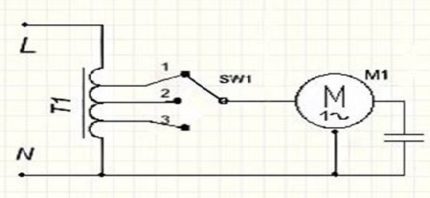
With decreasing voltage, the rotation speed of the exhaust blades decreases. At the output, we get an undistorted sinusoid, so when switching speeds, there is no interference that affects other devices and the fan itself.
Other types of regulators use a different principle. AT electronic modules PWM action is based on varying the instantaneous power transmitted to the load. AT semiconductor devices the working function is put on thyristors and triacs.
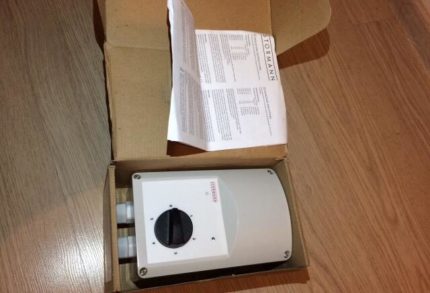
The device is controlled by a stepwise, phased change in the supply voltage. Manual adjustment.
The controllers are mounted on the wall as switches, with their help it is easy to change the number of revolutions of the exhaust fan.
With a special switch, the fan is connected to the desired node of the winding and the rotation speed of its blades drops. At the same time, energy consumption is reduced, which saves a resource.
The advantages of the models include reliability, durability, high overload capacity. The number of minuses includes the dimensions of the control unit: this is not always convenient if the device needs to be placed in a limited space.
Another two drawbacks are the impossibility of smooth adjustment and loss of energy for heating during adjustment. But when connecting temperature sensors, a timer, the process of changing speeds is easy to automate.
Varieties and features of devices
Transformer regulators are optimally suited for situations where you need to control the speed of rotation of the extractor blades manually. Their popularity is due to moderate cost, as well as the highest reliability among the "colleagues".
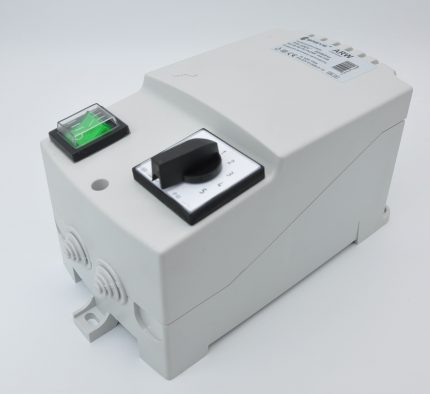
Difference of step controllers from others types of regulators - the ability to continuously work for a long time on unattended facilities.
The main technical characteristics of the devices:
- progressive voltage: 65-110-135-170-230 or 80-105-130-160-230 (numbers differ depending on the model);
- single-phase and three-phase - 220 and 380 V, respectively;
- weight can be up to 30 kg (all devices are rather bulky);
- current frequency: 50-60 Hz;
- device protection class: 00, 20, 54 IP.
Cases of devices are made of durable plastic and are able to withstand temperatures up to +40 degrees. Some groups of regulators belong to class B with a safety factor of up to 130 degrees.

Some models have alarm lamps and alarm indicators. There are also unique devices with the option of galvanic isolation from the network. Such controllers can be used in medical institutions.
As additional options, the controller may have terminals for connecting and controlling external devices (for example, for air damper drives).
According to the design and type of serviced fans, the controllers are divided into installed:
- on the walls;
- inside the walls;
- inside the ventilation unit;
- separate special cabinet if the system is working "smart House".
Some models are mounted on a Din-rail, controlled remotely.
If you need to adjust the speed on several fans, it is advisable to buy a multi-channel controller. There are models that can serve up to four or more devices simultaneously.
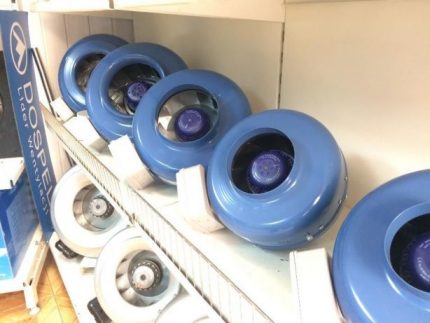
But, if the fans are located in different rooms, and the regulator will be one, then the parameters on the hoods will be the same. In the case when you need a different microclimate in different rooms, it is more convenient to connect several controllers.
The large weight and dimensions of such devices, the complexity of external control are overlapped by their advantages in stationary placement. The choice of a specific model depends on the technical features of the ventilation system.
Connecting the controller to the hood
Installation of the device is carried out indoors. It is made taking into account recirculation of air masses for cooling internal circuits.
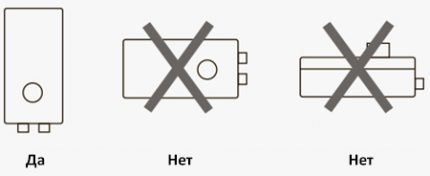
To correctly install the regulator, you must carefully read the instructions for the device.
Most models are designed for independent installation by the user and do not require special knowledge.
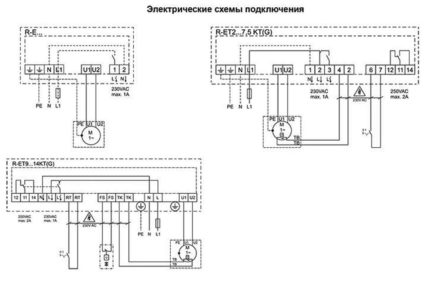
Installation of wall and wall devices is made with screws and dowels, which are selected in accordance with the dimensions and weight of the device. Fasteners are usually supplied, as is the wiring diagram for the fan controller.
The general pattern and sequence of actions are as follows:
- The regulator is first mounted, then connected to a cable that supplies current to the fan.
- The wires are divided into "phase", "zero", "ground" and cut, connected to the input and output terminals. It is important not to mix them up and make all the connections according to the instructions.
- The last step is to check the size of the cross section of the supply cable and connection for compliance with the maximum allowed voltage of the device.
The installation process for wall mounted controls is similar to the principle power outletslighting switches. You can use the old fan switch seat to mount the controller. In this case, the switch must be dismantled.
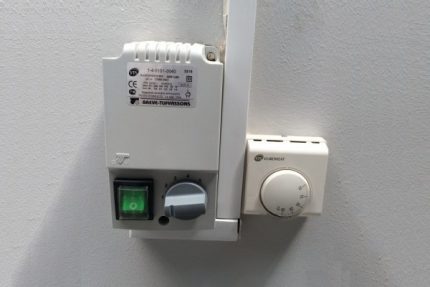
If the controller has thermal contacts, it is recommended to connect it to motors with external thermal protection contacts, connected to the terminals of the regulator TC. Such a circuit will reliably protect the main device.
When the thermal contacts open in case of overheating, the controller circuit breaks, the engine immediately stops and the emergency light comes on.
An engine without thermal contacts requires the installation of a separate thermal protection. Additionally, a jumper on the TC can be added to the circuit, but at the same time, the rated current of the regulator should be 20% higher than the maximum motor current.
How to reduce or increase speed?
In hoods, thanks to the stepwise adjustment of the fan speed, you can change the flow rate, which affects the overall air exchange.To control and use the method of changing the voltage.
The effectiveness of the device is proven in practice. A simple and inexpensive device suitable for domestic and public buildings. It can also perform additional functions.
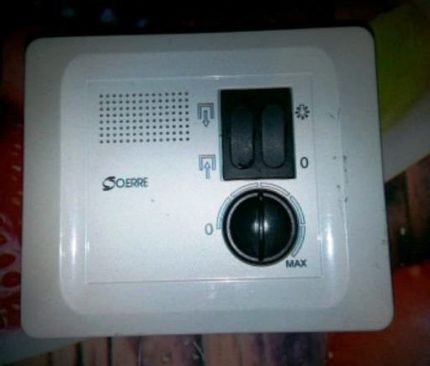
Speed increases or decreases mechanically. The modules have a wheel for stepwise changing the revolutions of the exhaust motor.
Before connecting the power, it is necessary to check the wiring and grounding efficiency. Often it is not recommended to turn the power on or off: continuous operation of the regulator ensures optimal temperature and prevents condensation in the device case.
If the device does not have an automatic restart function and an overheat has occurred, the causes must be eliminated. The switch for the engine cooling time is set to zero, then the device restarts.
Sound Reduction Recommendations
Often, the desire to adjust the fan speed is associated with an increased noise level that the device makes. The device should “sound” in the range up to 55 dB. The normal level is 30-40 dB.
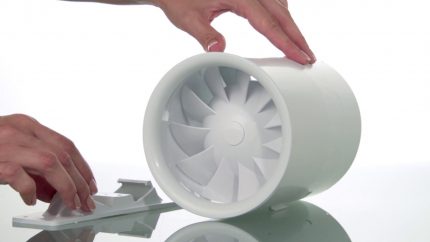
The controller does not actually reduce noise: at maximum speed, the fan makes the same sound as before. Quieter it works at lower revs.
To even reduce the noise level from the hood, even at maximum speed, you need to check the density of attachment of the main device body to the wall, a special niche. Clearances can be sources of additional vibration.
These gaps are sealed with foam rubber or polyurethane. Useful and inspection of fasteners, which should be well tightened. Reduce noise and thinisolon substrate in a vibrating surface.
And the most effective way to reduce hood noise is to choose silent channel fan.
Conclusions and useful video on the topic
How to connect a regulator to a fan. The example shows a thyristor controller, but the connection principle will help to understand the algorithm for working with a step device:
The features of connecting a channel fan through a speed controller + two more methods are discussed in the following video:
Stepwise adjustment of the fan speed makes the system less energy-consuming, quieter, precisely controlled. The controller ensures the safety of the main equipment, increases its service life. This is facilitated by safe start-up, protection against short circuits, overloads, overvoltages, and out-of-phase conditions.
The cost of acquiring the device pays off by saving money on the payment of energy consumed. It is important only to select the parameters of the regulator for the serviced fan. Most manufacturers have models matching tables that you can use for self-purchase. Do not place and consultation with the store manager.
Still have questions about the topic of the article? Ask them to our experts and other site visitors - the feedback block is located below. Also here you can share your own experience and theoretical knowledge, participate in discussions.

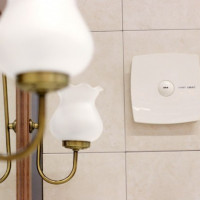 How to disassemble the exhaust fan in the bathroom: instructions for disassembling and cleaning the exhaust fan
How to disassemble the exhaust fan in the bathroom: instructions for disassembling and cleaning the exhaust fan 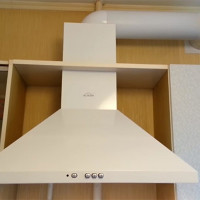 Installing a hood with a non-return valve: the nuances of selection and installation with valuable tips
Installing a hood with a non-return valve: the nuances of selection and installation with valuable tips 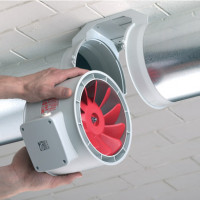 Ductless silent fans for hoods: existing types of devices and their operating parameters
Ductless silent fans for hoods: existing types of devices and their operating parameters 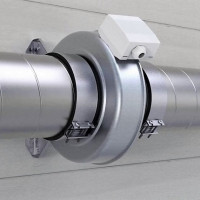 The best channel fans: TOP-15 popular devices + recommendations to potential buyers
The best channel fans: TOP-15 popular devices + recommendations to potential buyers 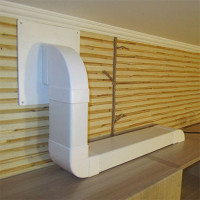 Plastic ducts for hoods: overview of types + installation rules
Plastic ducts for hoods: overview of types + installation rules 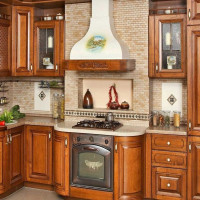 Plastic ventilation pipes for hoods: types, their characteristics, application
Plastic ventilation pipes for hoods: types, their characteristics, application  How much does it cost to connect gas to a private house: the price of organizing gas supply
How much does it cost to connect gas to a private house: the price of organizing gas supply  The best washing machines with dryer: model rating and customer tips
The best washing machines with dryer: model rating and customer tips  What is the color temperature of light and the nuances of choosing the temperature of the lamps to suit your needs
What is the color temperature of light and the nuances of choosing the temperature of the lamps to suit your needs  Replacement of a geyser in an apartment: replacement paperwork + basic norms and requirements
Replacement of a geyser in an apartment: replacement paperwork + basic norms and requirements